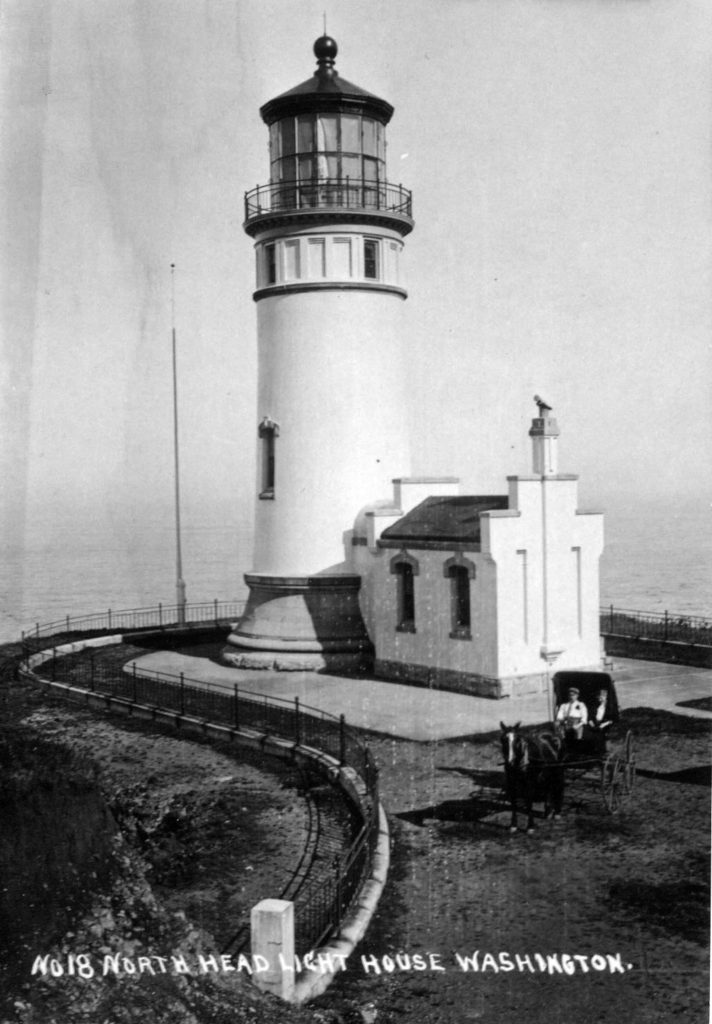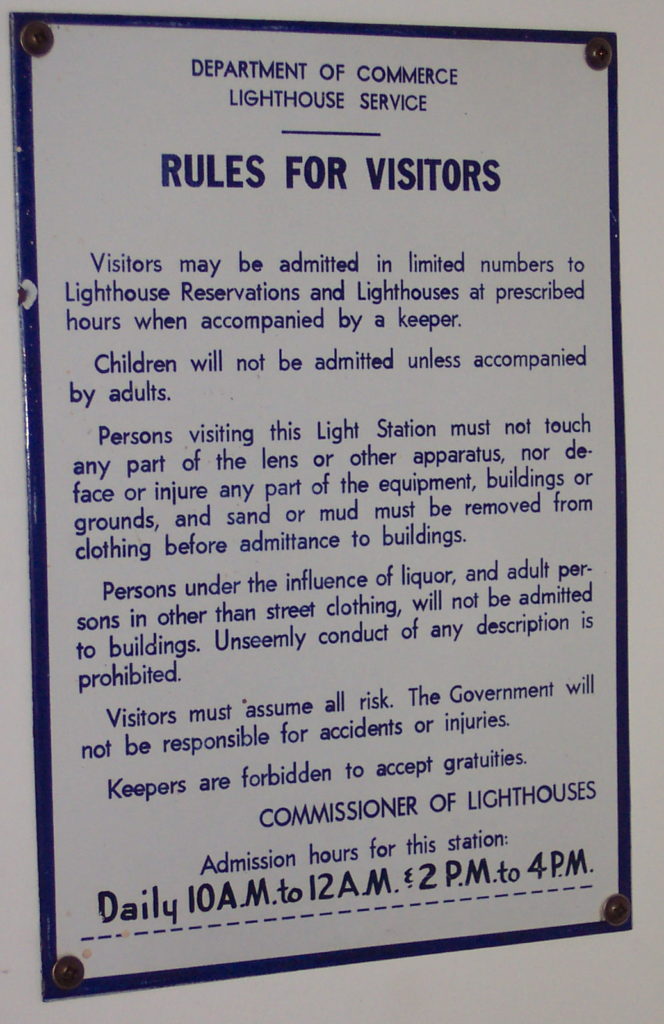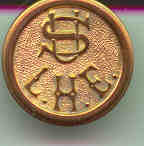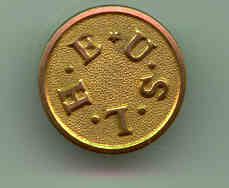The information that follows was compiled from a number of book and internet sources, along with the author’s accumulated knowledge after more than a decade of serving as a volunteer at lighthouses across the U.S.A. The intent is to provide general background information to other volunteer “keepers” of these important parts of our nation’s maritime history. It is accurate to the best of the author’s knowledge but represents only the tip of the iceberg to be sure. The author stands ready to be corrected and welcomes corrections or additions.
Lighthouse Jurisdiction The oversight of U.S. lighthouses was originally assigned to the Treasury Department, and until 1820 they fell under the jurisdiction of several different Treasury offices, including the Treasury Secretary himself. In 1820, an official with the auspicious title of “Fifth Auditor of the Treasury”, a man named Stephen Pleasonton, was assigned the “care and superintendence of the lighthouse establishment.” This term, “Lighthouse Establishment,” would be used for the next 90 years. There were some 60 lighthouses in the United States at this time. An 1832 listing showed 143 lighthouses; half of which were in New England. Pleasonton had little or no technical nor engineering experience, but he would reign supreme over American lighthouses for three decades. Giving himself the unofficial title of “general superintendent of lighthouses”, Pleasonton was apparently a very autocratic and thrifty bureaucrat. He contracted out the construction and repair of lighthouses, plus the purchase and installation of lamps and oil to light them. New Englander Winslow Lewis held these contracts for many years during Pleasonton’s rule. By the 1830s, American ship captains began to tout the superior brightness of lighthouses in Europe, but Pleasonton resisted using the newer, brighter, more efficient Fresnel lenses claiming their purchase was too expensive. The beauty of the Fresnel lens was two-fold: it needed only a single lamp as a light source; and it converted over 80% of that light to a useable beam to guide mariners. Yet they were expensive, even in that day. There are unproven allegations that Pleasonton was somehow related to Winslow Lewis, at least in business dealings if not by family, who provided lamps and fuel to our lighthouses, and that this relationship had something to do with the hesitancy to obtain the new Fresnel lenses.
Realizing the technical shortcomings of the Fifth Auditor, the 1837 lighthouse appropriations act by Congress ordered that a Board of Navy Commissioners evaluate and make recommendations about any proposed lighthouse site. Further, in 1838, Congress mandated that the new touted French Fresnel lenses be tried. Two lenses, one a fixed type and the other a revolving/flashing type, were imported and installed at the twin Navesink lighthouses in New Jersey, near the shipping entrance to New York harbor. The installation was completed in 1841. [Both of the lenses at Navesink were manufactured by the firm of Augustin Henry-Lepaute. The “Fixed” one was believed to have been subsequently moved to the Cape Disappointment, Washington, lighthouse, and later still to the North Head lighthouse, also at Cape Disappointment. It was thought to be on display at the Lewis and Clark museum at Cape Disappointment State Park, but latest research has cast doubt on this.] These lenses did in fact prove to be far superior to previous light mechanisms and were much less expensive and time consuming to operate as only one lamp per lighthouse was needed. In spite of these tests, Stephen Pleasonton continued in charge of U.S. lighthouses, and continued to resist the introduction of Fresnel lenses until he was ultimately removed from his position in 1852. A report by the Navy after an 1845 study of European lighthouses recommended many changes in the American lighthouse system. Then, in 1851, a Congressionally-mandated panel made a total review of lighthouse operation and administration. The report compiled by this panel was eventually adopted by Congress the following year. Legislation soon decreed the “placement of Fresnel lenses in lighthouses as rapidly as the Secretary of the Treasury thought best,” and also specifically required that a Fresnel lens be installed at the Brandwine Shoal lighthouse (New Jersey), making it the third U.S. lighthouse to have such a lens (Sankaty Head Light in Massachusetts had been the second one.) This act also created the Light-House Board, which would oversee U.S. lighthouses until 1910.
The United States Light-House Board, under the Treasury Department, became the governing body that was responsible for the upkeep and maintenance of all lighthouses in the United States in 1852. The term “U.S. Lighthouse Establishment” continued to be used when referring to the agency itself, while the term “U.S. Lighthouse Service” began to be used more often, especially in the later 1800s. There were 331 lighthouses, plus several “light ships” in service when this Board was created following complaints by the shipping industry of the previous administration of lighthouses. The single administrator, Stephen Pleasonton, was replaced by a Board comprised of nine members: two Army Engineer officers, two Army Topographical Engineer officers, two Navy officers, two civilian scientists, and the Secretary of the Treasury. The Board moved quickly in applying new technology, particularly in purchasing and installing new Fresnel Lenses and directing construction of lighthouses in offshore locations and along the Pacific coast. By the time of the Civil War, almost all lighthouses had Fresnel lenses. The nation was divided into twelve “Lighthouse Districts”, each with an engineer and an inspector. More districts were created as the number of lighthouses, particularly on the Great Lakes and on the west coast, increased during the latter half of the 19th century. The Board also oversaw the construction of the first lighthouses on the west coast, the first of which was built in 1853 on Alcatraz Island in San Francisco Bay. Many lighthouse artifacts, and even the lighthouses themselves from this era show the initials “U S L H E.” Board action in 1884 resulted in the light-house keepers being uniformed. The two early uniform buttons display this “USLHE” logo. [The word Light-House was hyphenated in official document reference to this Board, reflecting the grammatical usage of the day.]
Bureau of Lighthouses A Congressional act of 14 February 1903, created a Department of Commerce and Labor, and provided for the transfer of the Light-House Establishment, and its governing Light-House Board to this new agency. In 1910, the military-oriented Light-House Board was dissolved and the civilian “Bureau of Lighthouses”, still within the Commerce and Labor Department, was created. (Commerce and Labor would divide into two separate cabinet-level departments in 1913; The Bureau of Lighthouses would remain within the Commerce Department.) George R. Putnam was appointed as “Commissioner of Lighthouses” and he would serve until his retirement in May 1935. Harold. B. King would succeed him, and serve until the Bureau was absorbed by the Coast Guard. The unofficial “U.S. Lighthouse Service” name was more commonly used, and the old “Establishment” term fell into disuse. The letters “U S L H S” were found on many items of equipment during these years.

The Bureau of Lighthouses governed the lights until 1939, when it was merged into the U.S. Coast Guard. The Coast Guard had been formed in 1915 by the merger of the former “Revenue Cutter Service” and the “Life-Saving Service”. Thus lighthouse administration and operation returned to the federal department in which it had started in 1789. Today the Coast Guard falls under the Department of Homeland Security.
How many lighthouses are/were there in the United States? Ultimately, some 1500 lighthouses were built in the United States, many of these replacements for earlier structures at the same location. At the peak there were approximately 850 working lighthouse in service in the United States. Well that’s what one source says. Another states unequivocally that in 1910, when the Bureau of Lighthouses was created, there were 1,462 lighthouses and 51 lightships, and by 1925, there were 1,951 lighthouses and 46 lightships. Suffice it to say that, other than the armed forces, the Bureau of Lighthouses had perhaps the largest staff of any agency of the federal government. A letter written to Commissioner Putnam upon his 1935 retirement states that at that time there were “24,000 aids to navigation, 1,650 lighted buoys, 17,725 automatic gas lights, and 110 radio beacons,” and that there were 4,980 employees of the Bureau.
Lighthouse Architects Lighthouses were designed and built by many different people, as evidenced by the great variety of shapes and building materials found in those that still stand.
During the period of the Lighthouse Establishment headed by Stephen Pleasanton, the contractor Winslow Lewis either designed new ones or perhaps incorporated plans of those built before, often sub-contracting the actual construction. These early lighthouses were plagued by poor design and often poor quality of workmanship as well, and many simply didn’t withstand the harsh environments in which they were built. The earliest lights, usually made of wood, often succumbed to fire. In the 1840s Congress mandated that Army engineers design and build new lighthouses, but it wasn’t until 1852, when the Light-House Board was created, that trained engineers and architects became completely involved with lighthouse construction. Many of these men were officers in the Army Corps of Topographical Engineers, graduates of the military academy at West Point, the first such institution in the nation to teach engineering. One might think that the military would have “standard plans” for construction, but this doesn’t seem to be the case, although several instances of the same plans and specifications being used in more than one location do occur.
Many different army officers designed and supervised lighthouse construction. George Meade (1815 – 1872), of Civil War fame, Hartman Bache (1798 – 1872), William Raynolds (1820 – 1894) and Orlando Poe (1832 – 1895) are just a few of particular note. All probably used some original design elements combined with the proven designs and materials that had been used before them. The Light-House Board also employed civilian architects and draftsmen to help prepare lighthouse plans and specifications.
The “screw pile” lighthouse, built out in the water where bottoms were soft, was a new innovation during the Light-House Board era. Most of these were in the Chesapeake and Delaware bays, and along the reefs of the Florida Keys. Pilings were actually “screwed” down into the soft bottom and then braced together to support the lighthouse structure that would be built upon this platform. Alexander Mitchell (1780-1868), a blind Irish Architect, is given credit for devising and patenting the screw pile technology. Joseph Totten and George Meade among others, gained fame for adapting Mitchell’s ideas in the construction of such lighthouses.
Lighthouse Foundations Many of the country’s light towers are constructed on the solid rock of the coastline or offshore point where they stand. As noted above, lighthouses in some areas are built on foundations “screwed” or otherwise driven into the softer bottom of bays and coral reefs. Tall lighthouse towers on the sandy shores of the Mid-Atlantic States and along portions of the Great Lakes often have extensive foundations of timber cribbing and pilings. For example, Little Sable Lighthouse on Lake Michigan sits on a foundation of several feet of granite blocks atop timber cribbing which itself is above approximately 100 timber piles driven down into the sand. Likewise, the Sand Island Lighthouse in Alabama sits upon a double course of timbers resting on 171 piles. This extensive foundation has permitted the tower to still stand, alone in the ocean now that the entire island that once surrounded it has washed away. There are numerous other such examples.
Now About Those Curtains Around the Lens Historical records tell us that from the early Light-House Board days, a covering was lowered or drawn about the lens during daylight hours. Sometimes these were hung right around the lens; often they were hung just inside the glass of the lantern. There is anecdotal evidence that cleaning and even ironing these curtains was one more job expected of the keeper or more likely his wife. The Board’s 1902 edition of “Instructions to Light-Keepers“ states that “When the light is extinguished in the morning the keeper must hang the lantern curtains and immediately begin to put the apparatus in order for relighting.” The photo below of the North Head, Washington, lighthouse shows curtains drawn around the inside of the lantern room.

Further research and visits to lighthouses reveals that there were three different kinds of such coverings: curtains that were drawn around the lens, pull-down window shades on the inside of the glass panes of the lantern , and linen covers that were put right over the lens.. The word “curtains” in agency documents refers to all three types. It appears that actual pull-around curtains were used where 1st or 2nd order lenses were installed. These were the largest lantern rooms. Pull-down shades were more common with 3rd order or smaller lenses. The bag-type covers were more common with 5th or 6th order lenses. Three reasons have been found in various literature as to the purpose of curtaining the lens.
1. It prevented bright sunlight from being reverse-focused through the lens onto the oil-lamp at the center of the lens which could set it on fire. Anecdotal evidence suggests a few instances of such fires at the lamp or in the lantern did occur.
2. Prolonged exposure to sunlight over years will cause discoloring or other damage which would negatively affect the performance of the lens. I do not know if this is true or not. Many Fresnel lenses have been in towers for decades since the Coast Guard deactivated them without benefit of the protection of the curtains. I do not know of any scientific quantitative proof of such harmful changes, but there may be. The chemical composition of the glass prisms undoubtedly varied from maker to maker, and thus different lenses may be more or less susceptible to light damage than others.
3. Prolonged exposure to heat and sunlight will over time accelerate the deterioration of the “litharge”, the white/red-lead and linseed oil putty material that holds the prisms in the lens frame. This effect was known to keepers and lampists and is likely the most important of these three reasons. The curtains, along with the ventilation system built into lanterns, reduced heat build up within the lantern and lens and made working conditions in the lantern more tolerable for the keepers.
A fourth reason, and perhaps the best, reason for shading the lantern room during the day, was that this simple action kept it from getting terribly hot within that “greenhouse” of glass of the lantern room. Keepers that had work to do in the lantern during the day would surely have appreciated this.
How Far Can You See A Lighthouse
See more on this in the separate section entitled “From How Far Can You See A Lighthouse? How far a person can see out across the ocean or one of the Great Lakes is limited chiefly by the fact that the earth is round. The curvature of the earth will at some point make an object being viewed invisible, as it “goes over the edge.” This also applies to from how far out at sea a mariner can view something on shore. The light in a 100 foot tall lighthouse will be seen much farther away than the light in a 50 foot lighthouse. The physics of it all are complicated, but there is a very simple formula to use:
The square root of the height (in feet) of a lighthouse light x 1.32 = view distance in miles.
A light 150 feet above water level is visible 16 miles away by a viewer at water level. The higher above water level the object or the eye of the viewer is, the greater will be the distance at which the object, such as the light in a lighthouse, can be seen. This is why lighthouses are generally tall towers, or are built on cliffs or hills to raise them far above water level. The actual brightness of the light source itself is a factor in determining view-distance as well, as light is absorbed by the atmosphere over distance. This is why the largest and brightest First-Order lenses are found at major seacoast locations where they need to be seen from the greatest distance.
For a great chart, see Terry Pepper’s website. http://www.terrypepper.com/Lights/lists/visibility.htm
The Volunteers Charge As you go about your lighthouse volunteer duties, keep in mind one of the more important early instructions to keepers at all light stations. They were to “treat with civility and attention such strangers as may visit the Light-House under your charge, and as may conduct themselves in an orderly manner.” From the earliest days, beyond their utilitarian functions, lighthouses drew visits from those who recognized these charming structures on scenic sites. Some early keepers even complained about too many visitors keeping them from other work. In some locations, “extra” keepers were enployed just to tend to the many visitors so that the regular staff could accomplish their duties. The sign pictured here is from the Lighthouse Service years of the early 1900s.

Lighthouses Today Few lighthouses remain as active “aids to navigation.” Their usefulness and necessity has largely been minimized by modern navigational equipment on board the ships at sea. Those few that are still operational, although automated, are under the auspices of the Coast Guard. Most that remain, and there are thankfully still hundreds, serve as historic sites reminding visitors of the many years these iconic structures served an important role in our nation’s maritime history. Electrification, followed by automation, together with the lessened need for the lights, led to the demise of the long-time “keeper” or the “wickie” as he/she was often referred to in oil-lamp days. “Coasties” of the U.S. Coast Guard became the on-site keepers after the Lighthouse Service was absorbed by that agency in 1939.
As more and more lights became unneeded, all too often the station components and even the towers themselves were destroyed. Some were sold or otherwise surplused, but it was not until lighthouse preservation legislation was passed by Congress in 2000, that a formalized plan was developed to turn “surplus” lighthouses/light-stations over to organizations that would care for them. Thus many of those that survive today are parts of park agencies – county, state, or national. Others have been taken over by the municipalities in which they stand, while many more are owned and preserved by non-profit “Friends of” groups. Seek one out. They all seek volunteer help and support.
As stated at the beginning, this was put together to reinforce in my mind the many facts and concepts that I have learned about lighthouses, since my wife and I first became volunteer “summer keepers” on Seguin Island Maine some years ago. We still have much to learn, but I hope what is contained here can be a help to other lighthouse volunteers.


